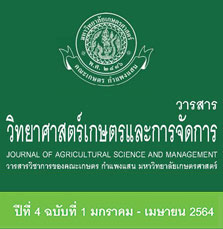Genetic diversity of pandan-like fragrant cucumbers as assessed by SSR markers
Keywords:
Cucumber, aroma, pandan-like fragrance, diversity, SSRAbstract
Thailand is a part of the center of diversity of cucumber (Cucumis sativus L.). Recently, a special type of cucumber, pandan-like fragrant cucumber, has been discoverred in Thailand. Pandan-like fragrance is a value-added trait. The fragrant cucumber is important and interesting as gene source in breeding new cucumber cultivar(s). However, at present, diversity and population structure of fragrant cucumbers are not known. The objective of this study was to assess genetic diversity and origin of the fragrant cucumbers. A set of cucumber germplasm of 96 accessions comprising 7 fragrant and 89 non-fragrant accessions were analyzed with 10 simple sequence repeat (SSR) markers locating on 7 chromosomes of cucumber. SSR analysis revealed that the markers detected 36 alleles in total with the number of alleles per marker ranging from 2 (SSR02895) to 6 (CS-SSR3) and an average of 3.6. Allelic richness between the fragrant and non-fragrant accessions was comparable, being 27.78 and 23.43, respectively. Overall gene diversity (HE) was moderate, being 0.52. HE between the fragrant and non-fragrant accessions was comparable, being 0.37 and 0.52, respectively. Neighbor-joining, principal component and STRUCTURE analyses generally showed that fragrant accessions were genetically different and were clustered into two groups with each group mingled with non-fragrant accessions. All together these results revealed that the fragrant cucumbers possess moderate genetic diversity and were different from non-fragrant cucumber. The results also suggested that the fragrant cucumbers have two different origins. The findings in this study are useful for conservation and utilization of fragrant cucumbers in breeding new cultivar(s).
References
Anderson, J.A., G.A. Churchill, J.E. Autrique, S.D. Tanksley and M.E. Sorrells. 1993. Optimizing parental
selection for genetic linkage maps. Genome 36: 181-186.
Benbouza, H., J.M. Jacquemin, J.P. Baudoin and G. Mergeai. 2006. Optimization of a reliable, fast, cheap and sensitive silver staining method to detect SSR marker in polyacrylamide gels. Biotechnology, Agronomy, Society and Environment 10: 77-81.
Buttery, R.G., L.C. Ling, B.Juliano and J.G. Turnbaugh. 1983. Cooked rice aroma and 2-acetyl-1-pyrroline.
Journal of Agricultural and Food Chemistry 31: 823-826.
Chakraborty, R. and L. Jin. 1993. Determination of relatedness between individuals by DNA fingerprinting.
Human Biology 65: 875-895.
de Wilde, W.J.J.O and B.E.E. Duyfjes. 2010. Cucumis sativus L. forma hardwickii (Royle) W.J. de Wilde &
Duyfjes and feralforma sativus. Thai Forestry Bulletin (Botany) 38: 98-107.
Evanno, G., S. Regnaut and J. Goudet. 2005. Detecting the number of clusters of individuals using the
software STRUCTURE: a simulation study. Molecular Ecology 14: 2611-2620.
FAOSTAT. 2019. Cucumbers and gherkins. (Online). http://www.fao.org/faostat/en/#data/QC. (April 13, 2021).
Fushimi, T. and R. Masuda. 2001. 2-acetyl-1-pyrroline concentration of the aromatic vegetable soybean
Dadacha-mame. In Lumpkin, T.A., and S. Shanmugasundaram (Eds.). Proceedings of the 2nd International Vegetable Soybean Conference, Tacoma (39p.). Washington, USA: Washington State University.
Goudet, J. 1995. FSTAT (Version 1.2): a computer program to calculate F-statistics. Journal of Heredity 86:
-486.
Langella, O. 1999. Populations a free population genetic software. Version 1.2.28. (Online).
http://bioinformatics.org/~tryphon/ populations. (April 2, 2021).
Lodhi, M.A., G.N. Ye, N.F. Weeden and B.I. Reisch. 1994. A simple and efficient method for DNA extraction from
grapevine cultivars and Vitis species. Plant Molecular Biology Reporter 12: 6-13.
Luckanatinvong, V. and P. Sornkeaw. 2011. Quality of blanched aromatic young coconut fruits for export.
Agricultural Science Journal 42(1(Suppl.)): 147-150.
Lv, J., J. Qi, Q. Shi, D. Shen, S. Zhang, G. Shao, H. Li, Z. Sun, Y. Weng, Y. Shang, X. Gu, X. Li, X. Zhu, J.
Zhang, R. van Treuren, W. van Dooijeweert, Z. Zhang and S. Huang. 2012. Genetic diversity and
population structure of cucumber (Cucumis sativus L.). PLos ONE 7: e46919.
Pramnoi, P., P. Somta, S. Chankaew, R. Juwattanasomran and P. Srinives. 2013. A single recessive gene
controls fragrance in cucumber (Cucumis sativus L.). Journal of Genetics 92: 147-149.
Pritchard, J.K., X. Wen and D. Falush. 2007. Documentation for STRUCTURE software: Version 2.2. (Online).
http://pritch.bsd.uchicago.edu/software/structure22/readme.pdf. (April 28, 2020).
Ren, Y., Z. Zhang, J. Liu, J.E. Staub, Y. Han, Z. Cheng, X. Li, J. Lu, H. Miao, H. Kang, B. Xie, X. Gu, X. Wang,
Y. Du, W. Jin and S. Huang. 2009. An integrated genetic and cytogenetic map of the cucumber genome. PLoS ONE 4:e5795.
Ruangnam, S., S. Wanchana, N. Phoka, C. Saeansuk, S. Mahatheeranont, S.J. de Hoop, T. Toojinda, A.
Vanavichit and S. Arikit. 2017. A deletion of the gene encoding amino aldehyde dehydrogenase
enhances the pandan-like aroma of winter melon (Benincasa hispida) and is a functional marker for
the development of the aroma. Theoretical and Applied Genetics 130: 2557-2565.
Tamura, K., G. Stecher, D. Peterson, A. Filipski and S. Kumar. 2013. MEGA6: Molecular evolutionary genetics
analysis version 6.0. Molecular Biology and Evolution 30: 2725-2729.
Watcharawongpaiboon, N., and J. Chunwongse. 2008. Development and characterization of microsatellite
markers from an enriched genomic library of cucumber (Cucumis sativus). Plant Breeding 127: 74-81.
Weir, B.S. 1996. Genetic data analysis II: Methods for discrete population genetic data, Sinauer Associates
Sunderland, Massachusetts, p. 445.
Yundaeng, C., P. Somta, S. Tangphatsornruang, S. Wongpornchai and P. Srinives. 2013. Gene discovery
and functional marker development for fragrance in sorghum (Sorghum bicolor (L.) Moench). Theoretical and Applied Genetics 126: 2897-2906.
Yundaeng, C., P. Somta, S. Tangphatsornruang, S. Chankaew and P. Srinives. 2015. A single base substitution in
BADH/AMADH is responsible for fragrance in cucumber (Cucumis sativus L.), and development of
SNAP markers for the fragrance. Theoretical and Applied Genetics 128:1881-1892.






